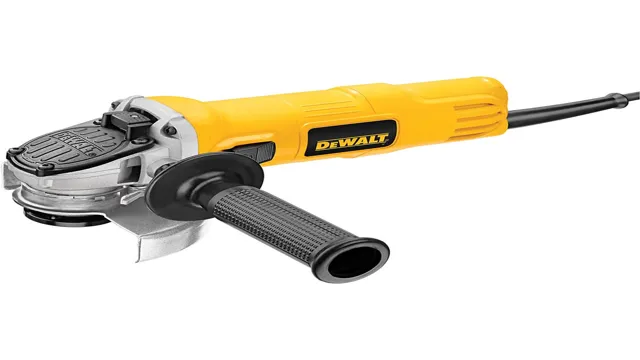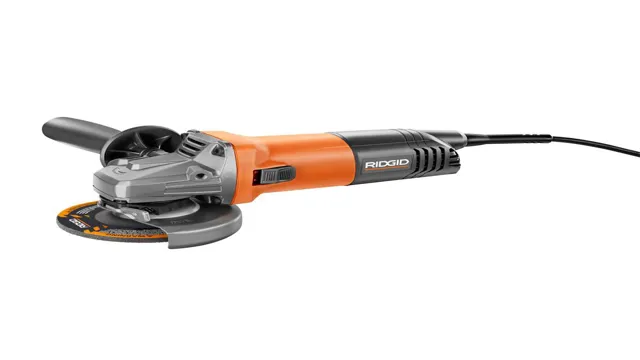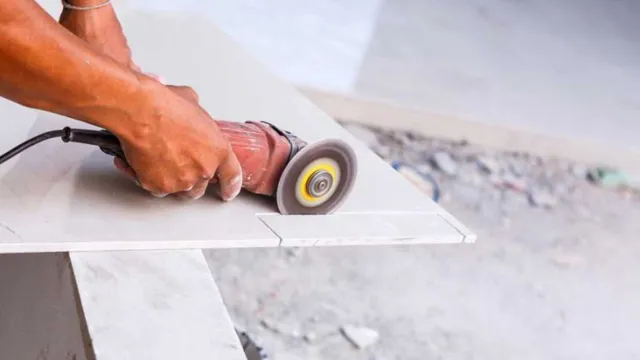What Amp Angle Grinder Do I Need for Tough Cutting Jobs: Everything You Need to Know

Angle grinders come in different sizes, shapes, and power outputs, which can be daunting. Choosing the right angle grinder amps for your project is a critical factor to consider when looking to get the job done efficiently and effectively. The amperage of angle grinders refers to the amount of electrical current that the motor draws, and this determines how powerful it is.
In this blog post, we’ll explore the factors to consider when choosing the right angle grinder amps and help you make an informed decision. So, whether you are a professional welder, a DIY enthusiast or need one for home improvement projects, keep reading.
Understanding Your Angle Grinder’s Amps
If you are in the market for an angle grinder, it is important to understand the amp rating of the tool before making your purchase. The amp rating refers to the power of the motor, and the higher the amps, the more powerful the grinder. It is useful to consider what tasks you will be using the grinder for, as this will determine the amp rating you need.
For light-duty tasks such as sanding and polishing, a 6-amp grinder should suffice, whereas more heavy-duty tasks like cutting through thick metal will require a higher amp rating of around 10 or 11 amps. It is also important to note that higher amps will result in a heavier tool, so it is a good idea to balance power and weight to ensure safe and comfortable use. Overall, understanding the amp rating of your angle grinder will help you choose the right tool for the job and maximize its efficiency.
What are Amps?
Amps If you’ve owned an angle grinder before, you might have noticed that different models come with different amp ratings. The amp rating of a grinder determines the amount of power it consumes and its ability to handle heavy-duty tasks. In simple terms, the higher the amp rating, the more powerful the grinder.
For example, a 7-amp angle grinder is suitable for light-duty tasks, such as cutting thin metal sheets, while a 15-amp model is perfect for heavy-duty tasks like grinding concrete or removing thick rust. It’s essential to choose the right amp rating for your angle grinder to avoid overworking the machine or causing damage to it. Additionally, different amp ratings require different amperage levels, which vary depending on your electrical outlet’s voltage.
Therefore, it’s crucial to check your grinder’s amperage requirements before plugging it into an outlet to prevent electrical hazards. Understanding your angle grinder’s amps can help you determine its capacity and prevent potential hazards, making your grinding experience safe and efficient.

Amps vs. Watts
Angle Grinder Amps When it comes to power tools, it’s important to understand the amps and watts they operate on. An angle grinder, for example, uses amps to measure the amount of electrical current flowing through the tool. The higher the amps, the more power the tool has to tackle tough jobs like cutting or grinding metal.
Think of it like horsepower in a car. More horsepower means more power to get the job done. Similarly, more amps mean more power to handle heavy-duty tasks.
However, it’s essential to remember that with great power comes great responsibility – and potential danger. It’s crucial to use an angle grinder with the appropriate amps for the job at hand. Using a tool with too few amps can lead to overheating and reduced efficiency, while using one with too many amps can cause the tool to become too powerful and uncontrollable.
So, make sure you understand the specific requirements of your project and select an angle grinder with the right level of amps for optimal results.
The Amp Range for Angle Grinders
When it comes to angle grinders, understanding your tool’s amps is crucial. Amps refer to the electrical current flowing through the grinder’s motor, and generally speaking, the higher the amp rating, the more powerful the tool is. Entry-level grinders typically have an amp rating of around 6 or 7, while heavier-duty ones can go up to 15 or more.
It’s important to choose the right amp rating depending on the task at hand. For lighter applications such as cutting tiles or sharpening tools, a lower amp grinder will suffice. However, for more heavy-duty tasks such as cutting thick metal or concrete, a higher amp grinder is necessary to handle the load.
In summary, understanding your angle grinder’s amp rating is key to achieving optimal performance and ensuring your safety while using the tool.
Determining Your Angle Grinder’s Use
When it comes to choosing the right amp angle grinder, you need to consider what you will be using it for. If you are going to be doing light-duty tasks like sanding or polishing, a lower amp grinder with around 6 amps should do the job just fine. However, for heavier-duty tasks like cutting or grinding, you will want a higher amp grinder with around 10 amps or more.
It’s important to choose the right tool for the job because using the wrong amp grinder can not only affect the quality of your work but also put you at risk of injury. So, take the time to determine what you will be using your angle grinder for and then choose the appropriate amp level to get the job done safely and effectively.
Light-Duty Tasks
Determining Your Angle Grinder’s Use for Light-Duty Tasks Angle grinders are powerful tools that can tackle a wide range of tasks, but it’s essential to determine the right use for your tool. When it comes to light-duty tasks, such as cutting through thin metal or sharpening blades, an angle grinder can be incredibly useful. These tasks don’t require the full power of an angle grinder, making it an ideal tool to have on hand for DIY projects or small jobs around the house.
However, it’s important to choose the right blade or attachment for the job at hand, as using the wrong tool can result in a damaged workpiece or injury. For light-duty tasks, it’s best to use a smaller angle grinder with a blade no larger than 4 inches in diameter. This size is perfect for precision cuts and allows for greater control over the tool’s movements.
Additionally, choosing a blade with a higher number of teeth will produce smoother cuts with less burring and heat. When working with thinner material, using a diamond blade can prevent the blade from binding and reduce the risk of kickback. In conclusion, determining your angle grinder’s use for light-duty tasks is essential to complete your project safely and efficiently.
By selecting the right blade or attachment and following proper safety guidelines, you can make precise cuts and sharpen blades with ease. Remember to always wear protective gear, keep the workpiece securely anchored, and never force the tool beyond its capabilities. With the right precautions, you’ll have a powerful tool at your disposal for all your light-duty tasks.
Medium-Duty Tasks
Angle Grinder When it comes to medium-duty tasks, an angle grinder can be a versatile tool to have in your toolkit. Determining your angle grinder’s use depends on the job at hand. It can be used for tasks such as cutting through metal pipes or ceramic tiles, sanding or deburring metal surfaces, and even polishing or grinding concrete floors.
Before using your angle grinder, it’s important to make sure you have the right attachment for the job. For example, a cutting disc is best for cutting metal while a grinding disc is ideal for smoothing out rough edges. Safety is also a key consideration, and it’s recommended to wear protective gear such as safety goggles and gloves and to use the tool at an appropriate speed.
By choosing the right attachment and taking proper safety precautions, your angle grinder can be a reliable tool for all your medium-duty tasks.
Heavy-Duty Tasks
When it comes to heavy-duty tasks, an angle grinder is the perfect tool to use for various challenging projects. Whether it’s for cutting or grinding, an angle grinder is designed to handle tough jobs that require substantial power and precision. But before you start using your angle grinder, it’s crucial to determine what kind of task you’ll be undertaking.
This will help you determine the appropriate angle grinder to use and also ensure your safety. For instance, if you’ll be cutting metal, you’ll need an angle grinder with an abrasive metal-cutting blade. On the other hand, if you’ll be grinding concrete, you’ll need a specialized concrete grinding wheel.
Understanding your specific needs and choosing the right angle grinder with the right wheel attachment will make your heavy-duty projects a breeze.
Choosing the Right Amps for Your Angle Grinder
When it comes to choosing the right amps for your angle grinder, it all depends on the type of work you’ll be doing. Generally, angle grinders come in two amp ratings: 7 amps and 9 amps. The 7-amp motor is suitable for lighter tasks around the house or DIY projects, such as grinding bolts and screws, sharpening blades, or cleaning up welds.
However, if you’re a professional welder or metalworker, you’ll need a 9-amp or higher angle grinder that can handle heavy-duty tasks, such as cutting metal rods, shaping steel plates, or removing rust and paint from large surfaces. Before making a purchase, consider the type of angle grinder you’ll need based on the project requirements, material hardness, and desired finish. Additionally, be sure to check the RPM (revolutions per minute) rating of the angle grinder, as this can affect the speed and precision of your work.
Remember, a higher RPM doesn’t always mean better performance, so choose an angle grinder that matches the expected workload and provides adequate power, control, and safety features. With the right amps on your angle grinder, you’ll be able to achieve the desired results with ease and efficiency.
4.5 – 6 Amps
When it comes to choosing the right angle grinder, one of the crucial factors to consider is the amperage. The amperage is the measure of the grinder’s power, and it determines its ability to handle tough grinding tasks. If you’re looking for a grinder that can handle medium-duty tasks, a
5 – 6 amp grinder should suffice. This range is ideal for grinding and cutting through materials such as concrete, steel, and wood. However, it’s important to note that the amperage isn’t the only factor to consider when selecting an angle grinder.
You should also consider the grinder’s speed, disc size, and safety features before making a final decision. Ultimately, the decision on which grinder to choose would depend on the intended application. So, before buying an angle grinder, make sure you consider your specific needs.
7 – 9 Amps
When it comes to finding the right angle grinder for your needs, choosing the right amps can make all the difference. Grinders in the 7-9 amp range are generally a good choice for those who need a reliable tool for occasional use. These grinders are powerful enough to handle most cutting and grinding tasks, but are still lightweight and easy to handle.
The benefit of a lower amp angle grinder is that you can use it for longer periods without causing fatigue. Additionally, these grinders often come at a more affordable price point than higher amp models. On the other hand, a lower amp grinder may struggle with heavy-duty tasks such as cutting through thick metal or concrete.
Ultimately, it’s important to consider what types of projects you will be using your angle grinder for before making a decision on amps. If you only plan to use it occasionally for small tasks, a 7-9 amp model may be perfect for your needs. However, if you require more power for frequent use or tougher jobs, it may be best to invest in a higher amp model.
Always prioritize your safety by wearing the proper protective gear and using caution when operating any power tool.
10 – 15 Amps
When it comes to choosing the right amps for your angle grinder, it’s important to consider what type of work you’ll be doing. For light to medium-duty tasks such as sanding or grinding small pieces of metal, a grinder with 10-15 amps should be sufficient. These grinders are compact and easy to handle, making them perfect for DIY projects or casual use at home.
However, if you’re planning on using your angle grinder for heavy-duty tasks like cutting through thick metal or concrete, you may want to invest in a grinder with more amps to ensure maximum power and efficiency. It’s also important to pay attention to the wheel size and the RPMs of the grinder to ensure it’s equipped to handle the task at hand. With the right amps and features, your angle grinder can be a versatile and reliable tool in your workshop or garage.
Conclusion and Final Thoughts
Well, my dear friend, choosing the right angle grinder is a lot like choosing the right partner. You want someone who’s just the right size, strong and dependable but not too overpowering. You want someone who’s easy to handle and maneuver into all the tight spots, but won’t wear you out in the process.
So, when it comes to finding the perfect amp angle grinder, it’s all about balance and compatibility. Choose wisely, and you’ll have a lifetime of happy grinding ahead of you!”
FAQs
What is an angle grinder and what is it used for?
An angle grinder is a handheld power tool used for grinding, cutting, and polishing. It is useful for tasks such as removing rust or excess material from a surface, cutting metal pipes, and shaping stone or concrete surfaces.
What size angle grinder do I need for cutting metal?
For cutting metal, a 4.5 inch or 5 inch angle grinder is generally sufficient. However, the size of the grinder also depends on the thickness of the metal being cut.
What is the difference between a corded and cordless angle grinder?
A corded angle grinder requires a power outlet to operate while a cordless angle grinder uses a rechargeable battery. Cordless grinders are more portable but may lack the power and runtime of corded units.
Can an angle grinder be used to grind concrete?
Yes, an angle grinder can be used to grind concrete. A diamond cutting wheel or grinding disc is recommended for this task.
What safety precautions should I take when using an angle grinder?
Always wear eye protection and gloves when using an angle grinder. Avoid wearing loose clothing or jewelry that can get caught in the grinder. Ensure that the grinder is unplugged or the battery is removed before changing the disc or wheel.
How do I choose the right angle grinder disc for the task?
The type of disc you choose depends on the task at hand. Grinding discs are appropriate for shaping and smoothing surfaces, while cutting discs are used for cutting metal or concrete. Wire brush or flap discs are useful for removing rust or paint.
What is the maximum RPM an angle grinder can handle?
The maximum RPM (revolutions per minute) an angle grinder can handle is usually indicated on the tool or in the user manual. Make sure to use a disc or wheel that is rated for the tool’s maximum RPM to avoid accidents or damage to the grinder.



